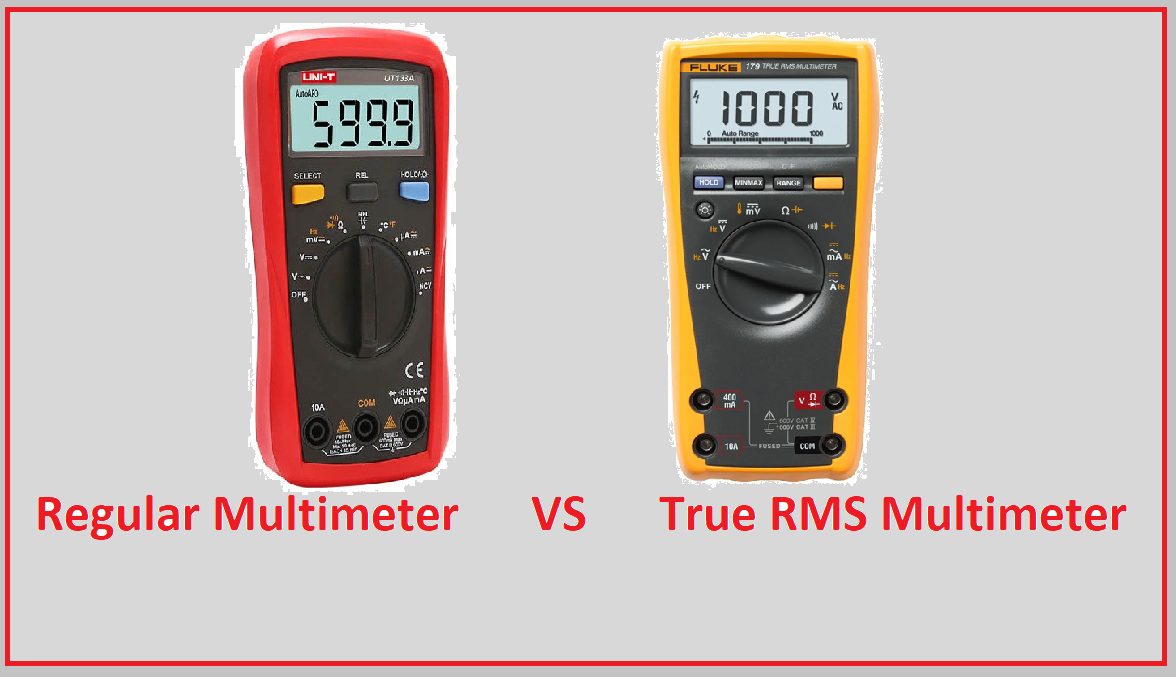A multimeter is one of the most important components that has been used for years in measuring and troubleshooting. So you must understand the different functions of the meter and whether the multimeter measure RMS or Peak.
Many peoples find it difficult that how to use a multimeter and what are the different tests we can perform using a multimeter. That’s why we have started the series on multimeter. I hope these articles will guide you in using the meters.
Before we get into the topic, first of all, we will discuss multimer and the difference between RMS and Peak value.
What is a multimeter?

A Multimeter is a tool for measuring electrical quantities like resistance, voltage, and current. All these meters (ohmmeter, voltmeter, and ammeter) that measures those quantities are combined to a single meter is known as multimeters.
The dial of a multimeter has these settings to measure
- DC Voltage and Current
- AC Voltage and Current
- Diode testing
- Capacitance
- Ohms
- Temperature
There are two leads of a multimeter. we have discussed in detail How to use a multimeter?. Also, while using a multimeter, you take reading from a multimeter and You might be thinking does a multimeter measure RMS or peak?
Difference between RMS and Peak Value?

- The peak value is the highest voltage that the waveform will ever reach, for example, the highest point on a mountain.
- The RMS (Root-Mean-Square) value is the effective value of the waveform. It is equal to the level of the DC signal that would provide the same average power.
Multimeter Measure RMS or Peak?
As we are measuring current accurately in different electronics components, modern industrial plants, Labs, homes, etc. That’s why it is important to have an idea about does a multimeter measure RMS voltage. The answer is pretty simple
Multimeters always measure the RMS value.
But keep in mind, the simple multimeter can only give you the correct value of RMS if your AC waveform is purely sinusoidal.
As we all know that only a rotating machine can produce pure sinusoidal AC. Every time it’s not necessary that we will get the pure sine wave. For example, the UPS we are using at home has no sinusoidal waveform. If we measure that will digital meter, we might get an error in reading. But the chances of error can be more in the case of the non-symmetrical wave shape.
What’s the solution?
In old or common multimeters the accuracy is often compromised. So it is suggested to buy a True RMS multimeter. This meter will always give you the correct reading for any wave. But if your wave is pure Sin you can use a Digital multimeter.
True RMS multimeter vs Regular multimeter

True RMS multimeter
- Meter will give you the correct RMS reading for any waveform.
- True RMS multimeters measure the “heating” potential of voltage.
- The power is proportional to the square of the RMS voltage, independent of the waveform.
- non-symmetrical waveforms, such as pulse trains, etc. can easily be measured with this meter.
Regular Multimeter
- Regular multimeter will only give an error-free reading in the case of a Pure sine wave.
- A multimeter uses a dc blocking capacitor to only measure the ac component of a signal.
- Only the AC components of the waveform are measured (dc is rejected).
- Sinewaves, triangle waves, and square waves, the ac and AC+DC values are the same. Because the waveforms do not contain a dc offset.
- These values can easily be measured by Regular meters.
Should You Use a True RMS Multimeter?
Yeah, you should use True RMS Multimeter. But as we have discussed earlier that you can use a simple multimeter for the symmetrical wave but you can’t use it for an unsymmetrical wave.
It is suggested in the circuit where accurate reading is required you should use the RMS Multimeter.
Frequently Asked Questions (FAQs)
Does a multimeter measure RMS?
Yes, Multimeter measures RMS value. But keep in mind simple multimeter will only measure the error-free RMS value of Symmetrical waves like sin, triangular, square wave, etc. But for waveforms like pulse train etc. only the True RMS value will give the correct RMS reading.
Which instrument is used to measure the peak voltage?
A thermionic voltmeter is an instrument used to measure the peak value and mean value of an AC waveform. But Mostly we used RMS reading for circuit designing.
What value does ammeter or voltmeter measure (RMS, Average, or Peak )?
Ammeter or voltmeter measure the RMS value. But measuring RMS values is more expensive than measuring average values. Mostly meter first measure the peak value and then apply the conversion formula
VRMS=0.707×Vpeak=1.11×Vavg
But keep in mind this is only valid for the sin wave. You will not get the correct reading for others.
There’s no doubt that the RMS multimeter is the most important part of an electrical circuit. Because of accuracy and preciseness, we always preferred the RMS value.
Because of advancements in technology different waveforms are used in circuits. We have tried to cover each aspect of “Does a Multimeter Measure RMS or Peak?” and look for more and add this next update. Do you have any questions? Let us know in the comment section below.

